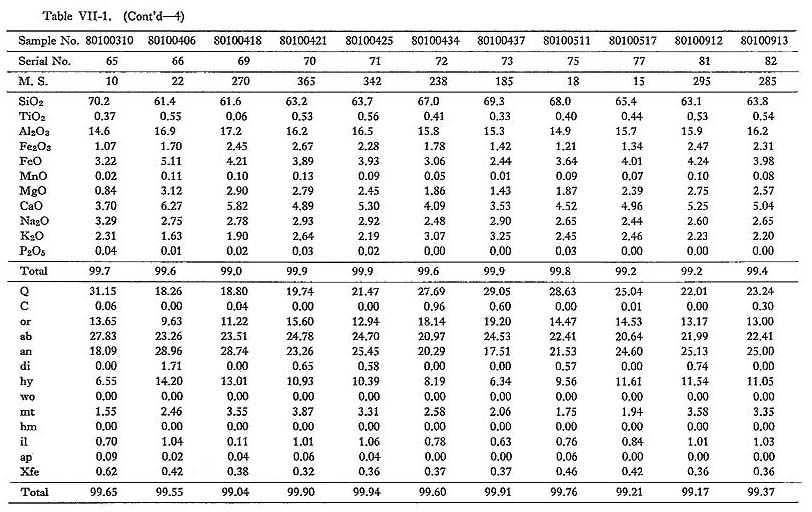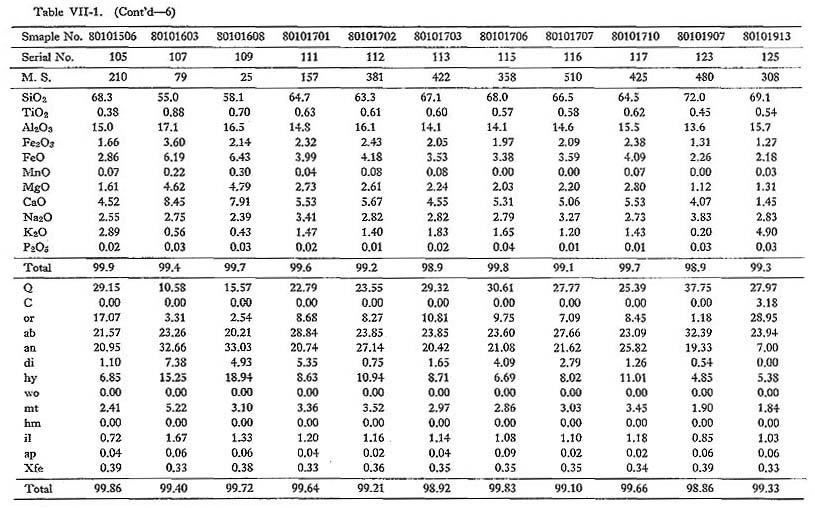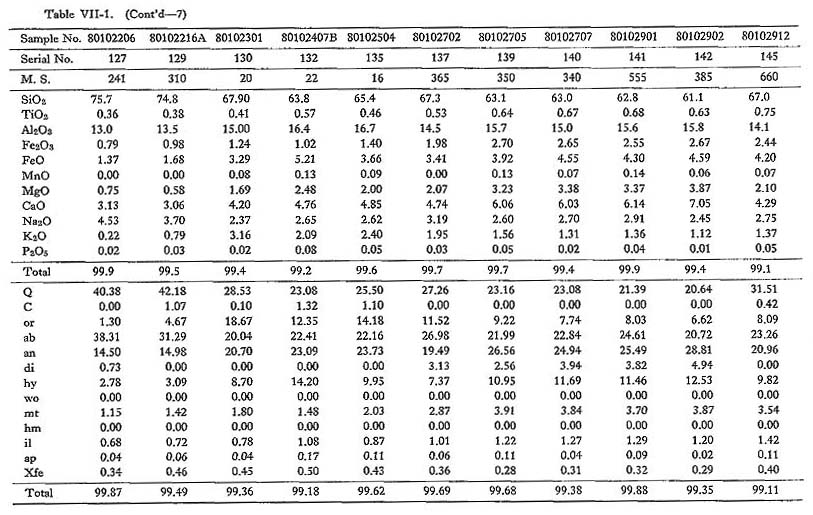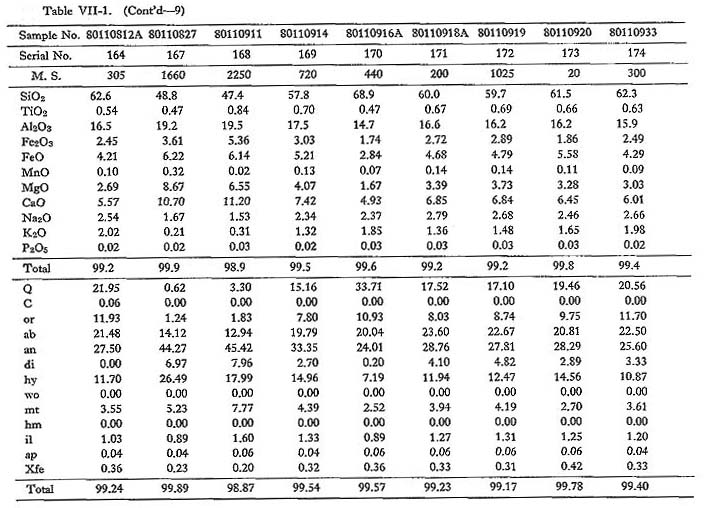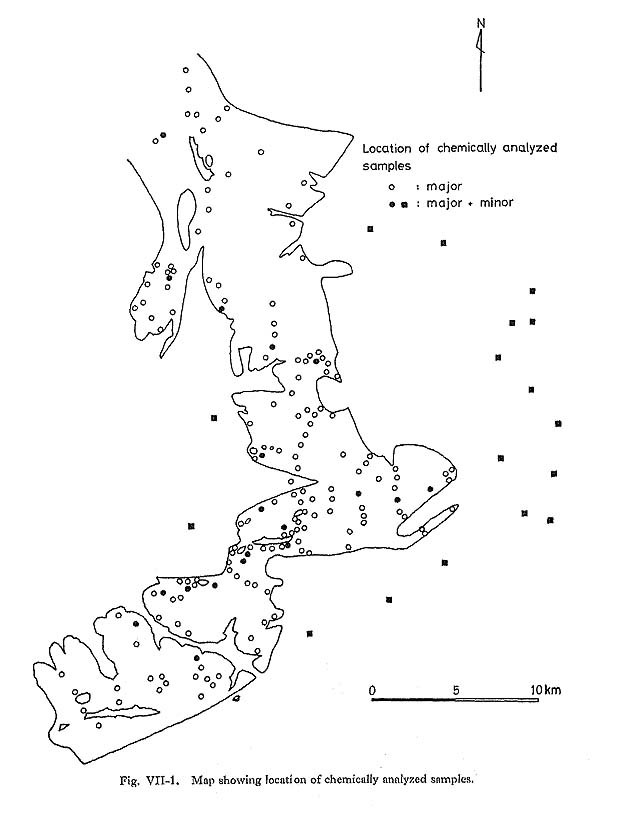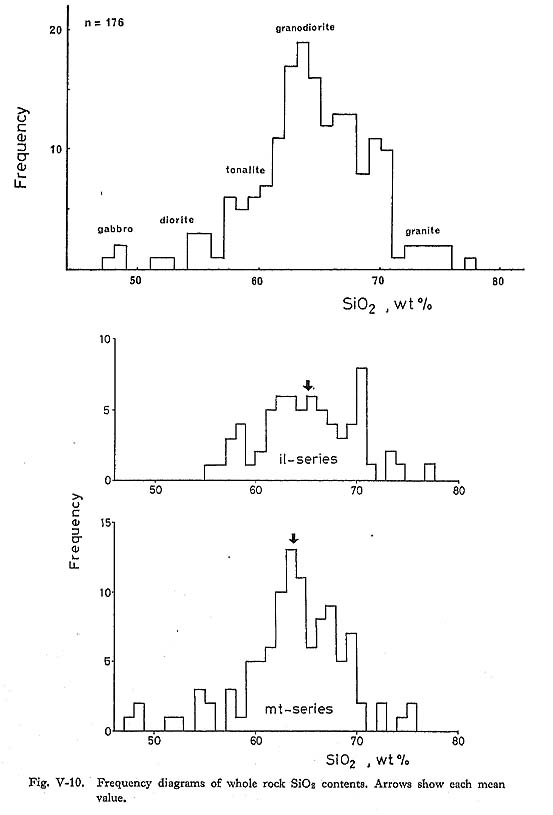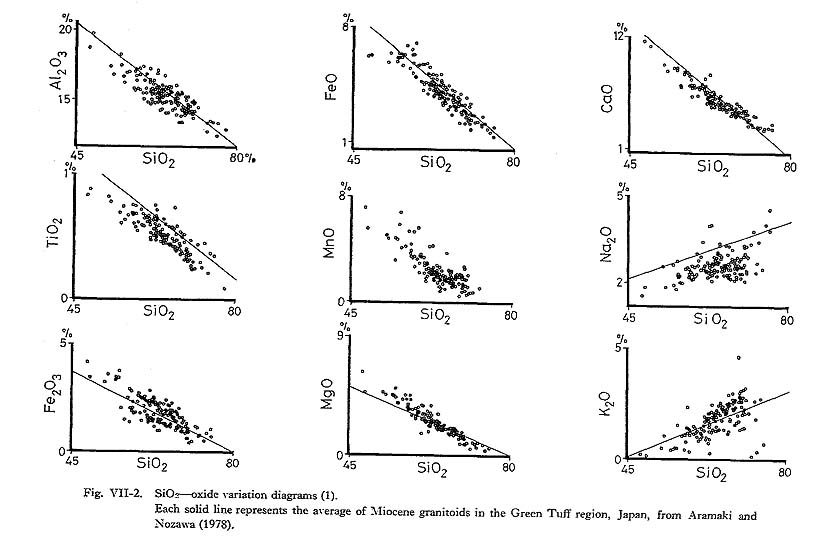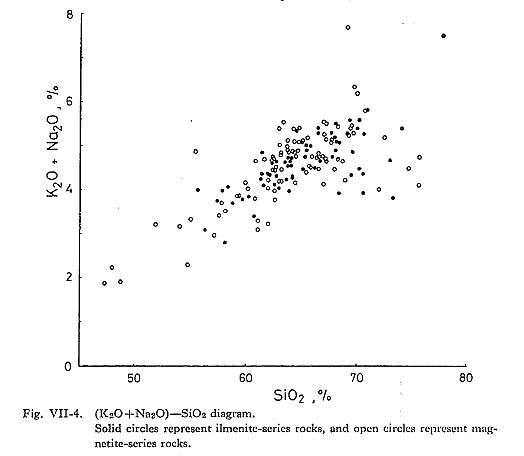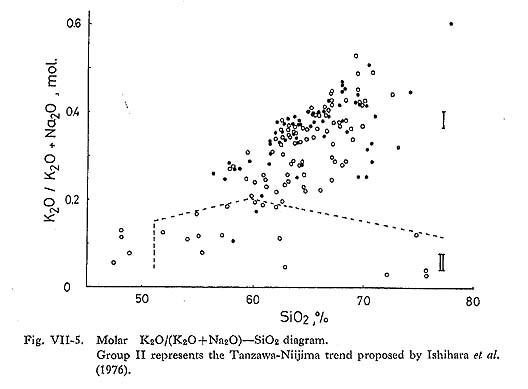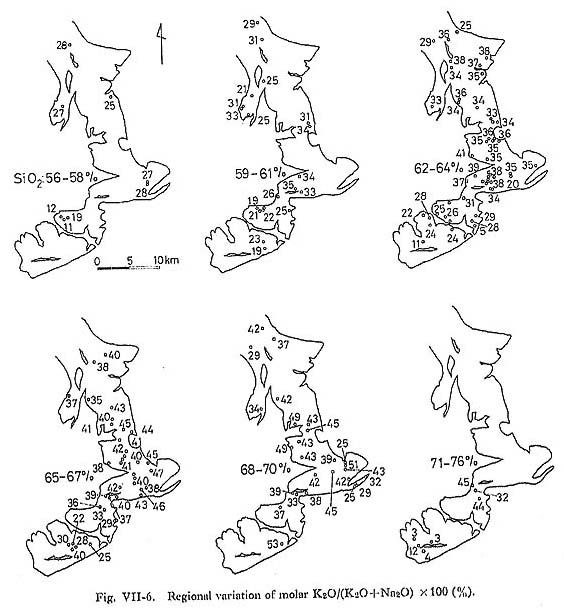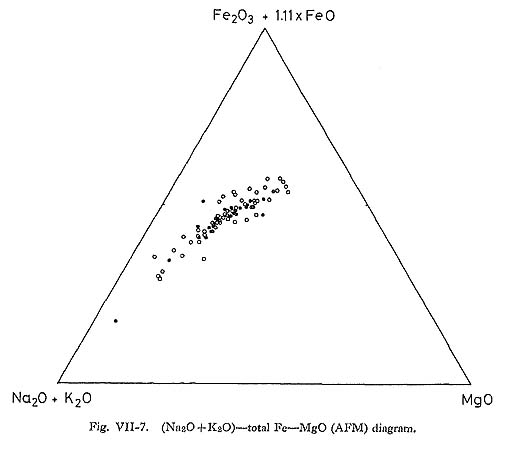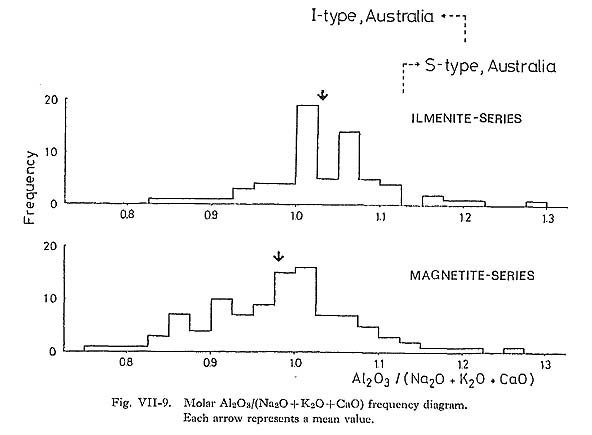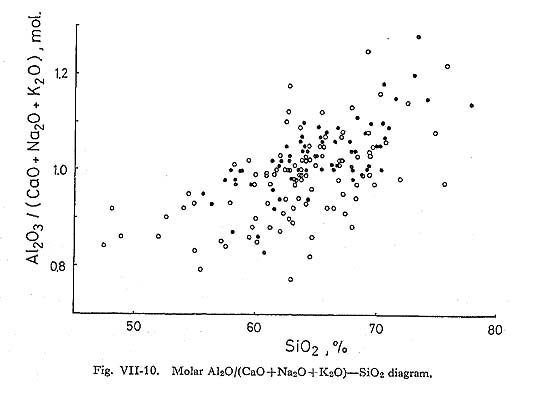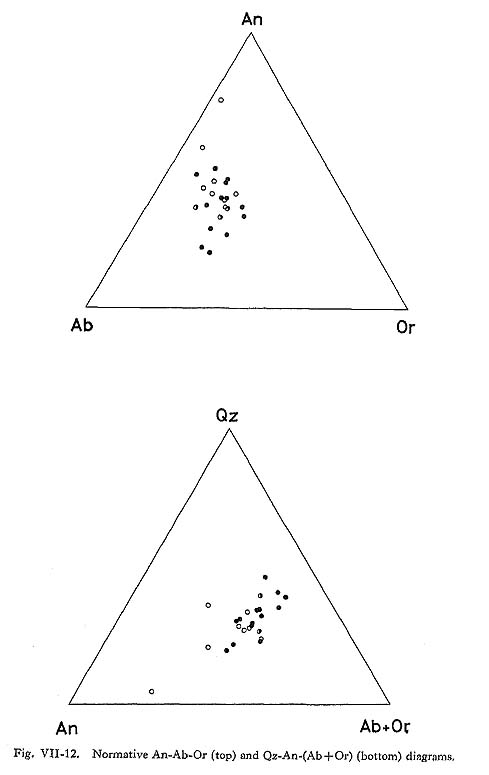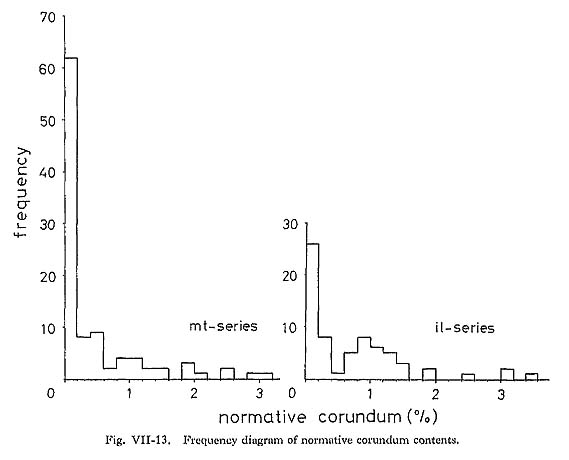CHAPTER VII
Whole-Rock Chemistry
1) Major Elements
|
The major elements of 173 representative samples from the Tokuwa batholith and 20 samples of the country rocks and xenoliths were analyzed using the X-ray fluorescence method. The results shown in Tables VII-1 and VIII-4 were reported by Shimizu and liyama (1981a). The method proposed by Matsumoto and Urabe (1980) was used for data correction. FeO contents were determined by classical wet chemical analysis. The location of the samples analyzed is shown in Fig. VII-1. The number of analyzed samples for each facies is approximately proportional to the exposed area of the rocks.
A considerable variation of chemical composition was obtained. Granitoids having 57 to 70 wt % SiO2 (tonalite to granodiorite) constitute 87.5% of the samples analyzed (see Fig. V-10-A). Chemical compositions of the sedimentary xenoliths are similar to those of the Kobotoke Group rocks.
As shown in Fig. VII-2 to -4, the variations in the chemical compositions can be demonstrated most clearly in SiO2-oxide variation diagrams ("Harker's diagrams"). The continuous variations of the chemical compositions are consistent with the gradational transition from gabbroids to granitoids observed in the field.
TiO2, Al2O3, total Fe, Fe2O3, FeO, MnO, MgO, and CaO contents decrease steadily as SiO2 increases, whereas Na2O and K2O tend to increase with the increase in SiO2. Lines drawn in Fig. VII-2 denote straight-line regression of Japanese Miocene granitoids from the Green Tuff region as established by Aramaki and Nozawa (1978). The Tokuwa batholith rocks are characterized by relatively high K2O contents and low MnO and Na2O contents, as compared with the regression lines drawn by Aramaki and Nozawa (1978). Most of the major elements in the Tokuwa batholith rocks show single and linear trends of variation. Some of them, however, show different trends. For example, variation of molar K2O/(K2O+Na2O) ratios with SiO2 shows two different trends (Fig. VII-5): the rocks from the southern marginal parts of the batholith adjacent to the Misaka Group andesitic rocks have a trend different from that of the main batholithic rocks. Figure VII-6 shows the variation of molar K2O/(K2O+Na2O) ratios within the batholith. A comparison of the chemical compositions of rocks having nearly the same SiO2 contents shows that the molar K2O/(K2O+Na2O) ratios of rocks from the northern and central parts of the batholith are generally higher than those from the southern parts of the batholith (Fig. VII-6). As mentioned by H. Shibata et al. (1959), Kato (1968a), and Morita (1970), the chemistry of rocks from the southern parts of the batholith very much resembles that of Tanzawatype granitoids.
The results of chemical analyses of the Tokuwa batholith rocks were plotted on an AFM diagram (Fig. VII-7). The trend of the Tokuwa batholith rocks on the AFM diagram corresponds to that of a calc-alkaline series based on Kuno's (1968) boundary.
Chappell and White (1974) divided eastern Australian granitoids into I-type and S-type based on chemical and mineralogical criteria. Most of the Tokuwa batholith rocks, both magnetite-series and ilmenite-series rocks, are plotted in the region of I-type on the ACF ((Al2O3-Na2O-K2O)-CaO-(FeO+MgO)) diagram (Fig. VII-8), Al2O3/(Na2O + K2O+CaO) frequency diagram (Fig. VII-9), and Al2O3/(Na2O+K2O+CaO)-SiO2 diagram (Fig. VII-10). Characteristic minerals of S-type granitoids such as muscovite, cordierite, Al2SiO5 minerals, and garnet, have not been observed in the Tokuwa batholith rocks. This is in good accordance with the conclusion by Takahashi et al. (1980) that most of ilmenite-series granitoids in Japan show the characteristics of I-type granitoids.
There is no difference in the total Fe contents between the two series of rocks (Fig. VII-3). However, for a given SiO2 value, magnetite-series granitoids have higher Fe2O3 and lower FeO contents than ilmenite-series granitoids (Fig. VII-3). Molar Fe2O3/ (FeO+Fe2O3) ratios of magnetite-series rocks range from 0.24 to 0.44 (mean 0.37), whereas those of ilmenite-series rocks range from 0.15 to 0.37 (mean 0.24). It can be concluded that most of the batholithic rocks show the trend of a calc-alkaline series as denned by Kuno (1968) and the characteristics of I-type granitoids as defined by White and Chappell (1977). Molar Fe2O3/FeO+Fe2O3) ratios are higher in magnetite-series than in ilmenite-series granitoids. CIPW NormNormative compositions of the Tokuwa batholith rocks are shown in Table VII-1 with chemical data on major elements. Some of the representative Qz-Ab-Or-An normative compositions can be compared to experimental data on granitic systems (Figs. VII-11 and VII-12). Most of the plots approach the Qz-Or join with the increase in SiO2 contents of rocks (Fig. VII-11). The compositions of the batholithic rocks do not represent "minimum melt" compositions, but are in the quartz primary field. The An-Ab-Or normative compositions of rocks are plotted in Fig. VII-12-A and lie on the plagioclase field, not on the low temperature trough as reported by Kleeman (1965). Compared with the Japanese granitoids investigated by Aramaki and Nozawa (1978) (Figs. VII-10 and -12), the compositions of the Tokuwa batholith rocks are plotted in the region closer to the An-Ab join (Fig. VII-12-A) and nearer the Qz apex (Fig. VII-12-B). This suggests that most of granitoids of the Tokuwa batholith were crystallized at relatively high temperatures or that the magma was not saturated with H2O throughout the crystallization, or that the bulk compositions do not indicate liquids.
Contents of normative corundum in the two series of granitoids are not markedly different (Fig. VII-13), and this is consistent with the single trend in the Al2O3-SiO2 variation diagram of the two series. However, normative corundum contents of most of ihmenite-series granitoids seem to be slightly higher than those of magnetite-series granitoids. Some magnetite-series samples enriched in normative corundum were probably formed by unusual processes: normative corundum-rich magnetite-series samples were more or less altered or observed near the boundary between the two series of granitoids. A shear zone 100 to 150 m in width was formed along the line from Okusenjo through the Yakiyama Pass to Sekisuiji. Many aluminosilicate alteration minerals such as alunite, pyrophyllite, sericite, and small amounts of dravite, zunyite, topaz, and dumortierite, are found in the altered rocks along this zone, and several hot springs and sulfur deposits (the Shiodaira-Nishibu sulfur mine) are also present along this shear zone. These altered rocks belong to normative corundum-rich magnetite-series.
|



